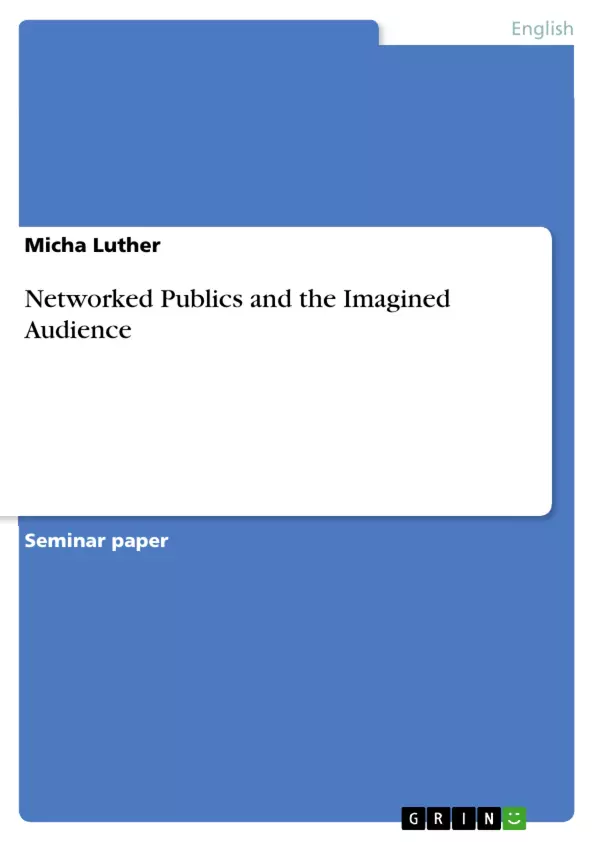Online platforms like social networks and blogs provide a space for people to share their thoughts and socialize with other people online. We can access content others created and on the other hand present our own content to others. However, the structure of these online environments is not always the same and neither is the audience that can access the content we created. The term “networked publics” is used by danah boyd in her essay Social Network Sites as Networked Publics: Affordances, Dynamics and Implications (2010) to describe these online environments with all of their characteristics. Boyd argues that the term ‘public’ itself is a very vague term describing different things in different contexts. The most important aspects of a ‘networked public’ are on the one hand the space and on the other hand the collective of people that are present on these online networks. However, it is an indisputable fact that online publics or networked publics respectively strongly deviate from what we know as ‘public’ from our traditional environment.
An important difference is the invisibility of our audience online. When we share our thoughts with a certain audience in a conventional (offline) environment we are normally more or less aware of whom we are talking to or writing to. In online net-works on the contrary, the audience remains rather opaque, in most cases we cannot know who will be reading the content that we provide to a public or semi-public environment online. We can only think of what our audience might be like. This is what frequently is referred to as the ‘imagined audience’, because we can only imagine the audience that we are talking to. Thus, we can consider the imagined audience as an integral element of networked publics. The fact that we do not really know our audi-ence sometimes poses problems, because we normally adapt content and style of what we want to share with the potential audience. When we do not know our audience, we sometimes do not know how to behave in an online public e.g. we do not know what language to use. One kind of language might be appropriate to one audience but inappropriate to another one. That is why I also want to point out possible effects of networked publics and imagined audiences on language use, e.g. how does language use differ depending on different imagined audiences?
Inhaltsverzeichnis (Table of Contents)
- I. Introduction
- II. Properties of networked publics
- II.1. Networked publics and site architecture
- II.2. Characteristics of bit-based networked architecture
- III. Networked publics: from blogs to social networks
- III.1. Content and structure of blogs
- III.2. Content and structure of social networks
- IV. The imagined audience
- IV.1. Blog audiences
- IV.2. Social network audiences
- IV.3 Language related to imagined audiences on different networked publics
- V. Conclusion
Zielsetzung und Themenschwerpunkte (Objectives and Key Themes)
This paper explores the concept of "networked publics" as defined by danah boyd, analyzing the characteristics of online platforms like blogs and social networks. It investigates the nature of the imagined audience in these online environments and its impact on language use. The paper aims to understand how the architecture and structure of networked publics influence the way individuals interact and communicate with each other online.
- The characteristics of networked publics and their differences from traditional publics
- The role of site architecture in shaping online interactions
- The concept of the imagined audience and its implications for communication
- The influence of networked publics on language use
- The distinct features of blogs and social networks as networked publics
Zusammenfassung der Kapitel (Chapter Summaries)
The introduction defines the concept of networked publics and introduces the central theme of the imagined audience. It highlights the differences between online and offline communication, particularly the invisibility of the audience in online environments. The paper also outlines its focus on analyzing blogs and social networks as examples of networked publics.
Chapter II explores the properties of networked publics, focusing on site architecture and its impact on user interactions. It distinguishes between atom-based and bit-based architecture, highlighting the unique characteristics of bit-based architecture that contribute to the flexibility and dynamism of networked publics.
Chapter III examines the specific features of blogs and social networks as networked publics. It analyzes the content, structure, and affordances of these platforms, providing insights into how they shape user experiences and communication styles.
Chapter IV delves into the concept of the imagined audience, exploring how individuals perceive and interact with their audiences on blogs and social networks. It analyzes the language used in these contexts and how it reflects the imagined audience.
Schlüsselwörter (Keywords)
Networked publics, imagined audience, site architecture, blogs, social networks, online communication, language use, bit-based architecture, affordances, online platforms, content structure.
- Citar trabajo
- Micha Luther (Autor), 2014, Networked Publics and the Imagined Audience, Múnich, GRIN Verlag, https://www.grin.com/document/283190



